
Welcome to Mothers Need
Find everything you need for your children, from baby to teenager!
Latest
Our latest In Depth Reviews

How To Clean Dr. Brown’s Bottle Warmer
March 1, 2024
0
Keeping your baby's bottle warmer clean is important for keeping your baby healthy and ensuring the warmer works properly. Sometimes, though, ...
Parenting Hacks
Toxic or Safe? EVA Foam Uncovered
February 29, 2024
0

Banister Guard: Best Baby Gate Revealed
January 19, 2024
0

Childproofing Your Home: Protecting Little Explorers
December 29, 2023
0

Best Nighttime Pull-Ups for Your Little Ones
December 28, 2023
0

Merlin Suit Review: Nighttime Magic for Babies
December 15, 2023
0

How Often Should You Replace Baby Bottles: A Guide for Parents
December 15, 2023
0

Best Sippy Cups for Oral Development in 2024
January 26, 2024
0
Latest
Reviews, Comparisons and News

Founded in 2020, Mothers Need is dedicated to supporting mothers and caregivers through the beautiful, challenging journey of raising children.
Have something you want us to review? Get in touch!
Subscribe








